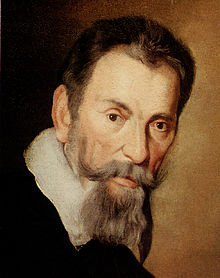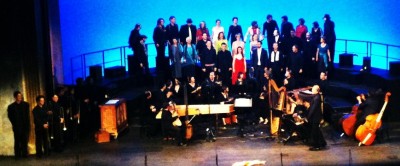NIKOLAY BORCHEV outstanding as ORFEO at Champs Elysees.

Nikolay Borchev
In the concertproduction of Claudio Monteverdi´s opera Orfeo by Thomas Hengelbrock and the Balthasar Neumann ensemble and Choir, is the young White Russian tenor NIKOLAY BORCHEV outstanding and convincing in the titelrole as ORFEO at Theatre des Champs Elysees, Paris.
Review and applause photos by Henning Høholt
PARIS: The concertprodcution of Orfeo, which partly was performed in costumes and with acting, became a highlight in the line of outstanding productions that Theatre des Champs Elysees year after year presents to its large audience
survey, ED was defined as mild (occasional), moderate cialis online ASSESSMENT.
.
L’Orfeo (SV 318), sometimes called L’Orfeo, favola in musica, is a late Renaissance/early Baroque opera by Claudio Monteverdi, with a libretto by Alessandro Striggio
. It is based on the Greek legend of Orpheus, and tells the story of his descent to Hades and his fruitless attempt to bring his dead bride Eurydice back to the living world
. Orfeo was written in 1607 for a court performance during the annual Carnival at Mantua, L’Orfeo is one of the earliest music dramas still regularly performed
.
Within the musical theatre at the beginning of the 17th century the traditional intermedio—a musical sequence between the acts of a straight play—was evolving into the form of a complete musical drama or “opera”. Claudio Monteverdi’s L’Orfeo moved this process out of its experimental era, and provided the first fully developed example within the new genre.
This is the background to the history as we enjoyed it in Paris this Friday evening June 22nd. 2012. In his published score Monteverdi lists around 41 instruments to be deployed, with distinct groups of instruments used to depict particular scenes and characters. Thus strings, harpsichords and recorders represent the pastoral fields of Thrace with their nymphs and shepherds; heavy brass illustrates the underworld and its denizens. Composed at the point of transition from the Renaissance era to the Baroque, L’Orfeo employs all the resources then known within the art of music, with particularly daring use of polyphony. The work is not orchestrated as such; in the Renaissance tradition instrumentalists followed the composer’s general instructions but were given considerable freedom to improvise. This separates Monteverdi’s work from the later opera canon, and makes each performance ofL’Orfeo a uniquely individual occasion.
If it has been a staged opera, the history is as follows, In this concertversion, we have the history as a help to understand, what actually was being presented on stage in this good version of Orfeo.

Claudio Monteverdi 1567-1643
The actions take place in two contrasting locations: the fields of Thrace (Acts 1, 2 and 5) and the Underworld (Acts 3 and 4). An instrumental toccata (English: “tucket”, meaning a flourish on trumpets) precedes the entrance of La musica, Sung by Johannette Zomer, representing the “spirit of music”, who sings a prologue of five stanzas of verse. After a gracious welcome to the audience she announces that she can, through sweet sounds, “calm every troubled heart.” She sings a further paean to the power of music, before introducing the drama’s main protagonist, Orfeo, who “held the wild beasts spellbound with his song”.
Act 1: To reveal a pastoral scene. Orfeo, Nikolay Borchev, and Euridice, Katja Stuber, enter together with a chorus of nymphs and shepherds, who act in the manner of a Greek chorus, commenting on the action both as a group and as individuals. A shepherd announces that this is the couple’s wedding day; the chorus responds, first in a stately invocation (“Come, Hymen, O come”) and then in a joyful dance (“Leave the mountains, leave the fountains”). Orfeo and Euridice sing of their love for each other, before leaving with most of the group for the wedding ceremony in the temple. Those left on stage sing a brief chorus, commenting on how Orfeo has been changed by love from one “for whom sighs were food and weeping was drink” to a state of sublime happiness.
Act 2: Orfeo returns with the main chorus, and sings with them of the beauties of nature. Orfeo then muses on his former unhappiness, but proclaims: “After grief one is more content, after pain one is happier”. The mood of contentment is abruptly ended when La messaggera, Anna Bonitatibus, enters, bringing the news that, while gathering flowers, Euridice has received a fatal snakebite. The chorus expresses its anguish: “Ah, bitter happening, ah, impious and cruel fate!”, while the Messaggera castigates herself as the bearing of bad tidings (“For ever I will flee, and in a lonely cavern lead a life in keeping with my sorrow”)
. Orfeo, after venting his grief and incredulity (“Thou art dead, my life, and I am breathing?”), declares his intention of descending to the Underworld and persuading its ruler to allow Euridice to return to life. Otherwise “I shall remain with thee in the company of death”. He departs, and the chorus resumes its lament.
Act 3: (Now in the Underworld): Orfeo is guided by Speranza, Anna Stéphany, to the gates of Hades. Having pointed out the words inscribed on the gate (“Abandon hope, all ye who enter here”), Speranza leaves. Orfeo is now confronted with the ferryman Caronte, Marek Rzepka, who addresses Orfeo harshly and refuses to take him across the River Styx. Orfeo attempts to persuade Caronte by singing a flattering song to him (“Mighty spirit and powerful divinity”), but the ferryman is unmoved. However, when Orfeo takes up his lyre and plays, Caronte is soothed into sleep. Seizing his chance, Orfeo steals the ferryman’s boat and crosses the river, to enter the Underworld while a chorus of spirits reflects that nature cannot defend herself against man: “He has tamed the sea with fragile wood, and disdained the rage of the winds.”

Balthasar-Neumann-Ensemble, Soloists and Choire. In front to the right the conductor Thomas Hengelbrock. Foto: Henning Høholt.
Act 4: In the Underworld. Proserpina,: Queen of Hades, Anna Bonitatibus, who has been deeply affected by Orfeo’s singing, petitions King Plutone, her husband, for Euridice’s release. Moved by her pleas, Plutone, Guido Loconsolo, agrees subject to the condition that, as he leads Euridice towards the world, Orfeo must not look back. If he does, “a single glance will condemn him to eternal loss”. Orfeo enters, leading Euridice and singing confidently that on that day he will rest on his wife’s white bosom. But as he sings a note of doubt creeps in: “Who will assure me that she is following?”. Perhaps Plutone, driven by envy, has imposed the condition through spite? Suddenly distracted by an off-stage commotion, Orfeo looks round; immediately, the image of Euridice begins to fade. She sings, despairingly: “Losest thou me through too much love?” and disappears. Orfeo attempts to follow her but is drawn away by an unseen force. The chorus of spirits sings that Orfeo, having overcome Hades, was in turn overcome by his passions.
Act 5: Back in the fields of Thrace Orfeo, in a long soliloquy, laments his loss, praises Euridice’s beauty and resolves that his heart will never again be pierced by Cupid’s arrow. An off-stage echo repeats his final phrases. Suddenly, in a cloud, Apollo, Miljenko Turk, descends from the heavens and chastises him: “Why dost thou give thyself up as prey to rage and grief?” He invites Orfeo to leave the world and join him in the heavens, where he will recognise Euridice’s likeness in the stars. Orfeo replies that it would be unworthy not to follow the counsel of such a wise father, and together they ascend. A shepherds’ chorus concludes that “he who sows in suffering shall reap the fruit of every grace”, before the opera ends with a vigorous moresca.
The Balthasar-Neumann-ensemble and the Balthasar-Neumann-Choir has done a very good work in the preparation and working with this demanding opera, which sounds impressiv. Thomas Hengelbrock leaded it all with entusiasme, and he had several good groups around him the deifferent versions of the continuo, and the constantly cahnging instruments from the two claviatur players. We enjoyed the Theorbe soloists, who layed the different musically background deliciously.
